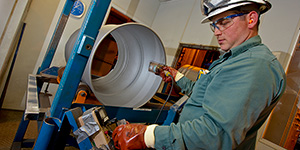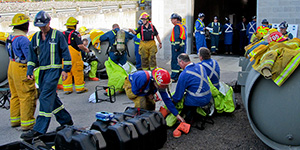A Top Priority

In addition to the conventional safety risks common to all industrial facilities, nuclear fuel processing and fabrication plants have chemical and radiological hazards that need to be managed.
The major process safety concerns at nuclear fuel processing facilities are related to anhydrous hydrogen fluoride handling and the risk of a criticality event if insufficient care is taken with the arrangement of fissile materials. Both risks are managed through the rigorous control of materials. Fuel fabrication facilities operate with strict limits on the enrichment level of uranium that is handled in the plant. Enrichment levels exceeding 5% U235 are prohibited, essentially eliminating the possibility of inadvertent criticality.
Employees wear the appropriate personal protective equipment for the task at hand. This includes safety boots, hard hats, safety goggles, hearing protection and gloves, as well as respirators and, where needed, personal dosimeters to monitor exposures.
Radiation risks related to fuel processing operations have been studied extensively and are well understood. Radiation sources and exposures are carefully monitored and on-site specialists in radiation protection educate workers on best practices to minimizing radiation exposures by:
- Distance – putting a greater distance between a person and the source of radiation
- Shielding – placing something that absorbs the radiation between the person and the source
- Time – reducing the amount of time a person is exposed
Rigorous quality control measures are employed at all process points in order to ensure traceability of all components in case of failures. All of these factors contribute to the safe operations at Cameco facilities.
Safety in Our Communities

Cameco's fuel processing facilities are located near, or within, urban settings. To minimize potential industrial, chemical or radiological hazards for these populations, a robust system of defense-in-depth measures are in place. Defence-in-depth is a proven approach used in many industrial settings as well as by emergency responders. Based on the concept of multi-layers of containment, the system aims to ensure that workers, public and the environment are protected.
Well-trained and equipped emergency response teams ensure that any potential emergency situation can be handled quickly, safely and effectively. Annual third-party inspections and emergency drills ensure ongoing skill development and preventive practices are continually enhanced.






